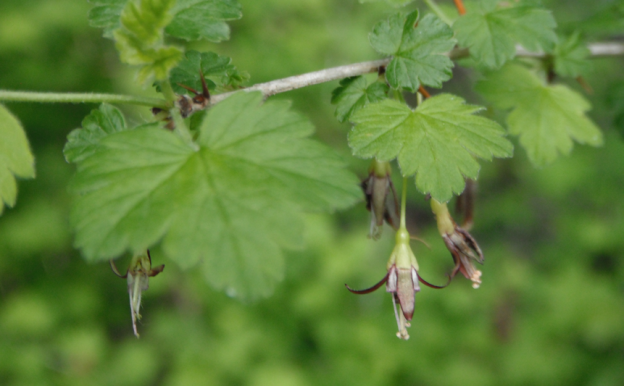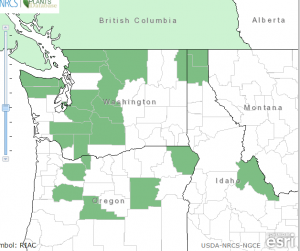Coast Black Gooseberry The Currant Family–Grossulariaceae
Ribes divaricatum Douglas
(rye-BEEZ di-vair-ih-KAY-tum)
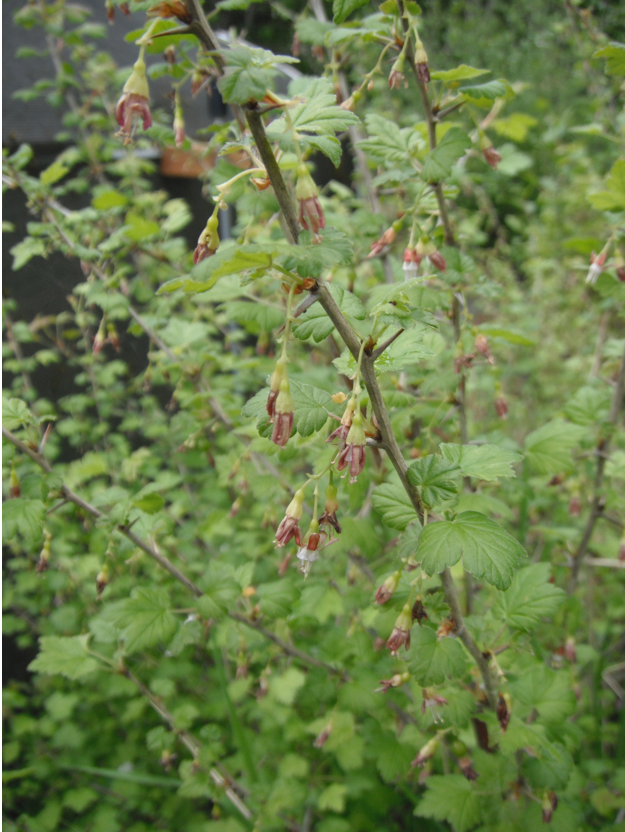 Names: This species has many common names including Wild Black Gooseberry, Spreading Gooseberry, Coast (or Coastal) Black Gooseberry (or Currant), Straggly Gooseberry (or Currant), and Straggle Bush. In the UK it is known as Worcesterberry. Divaricatum means spreading or branching with two forks.
Names: This species has many common names including Wild Black Gooseberry, Spreading Gooseberry, Coast (or Coastal) Black Gooseberry (or Currant), Straggly Gooseberry (or Currant), and Straggle Bush. In the UK it is known as Worcesterberry. Divaricatum means spreading or branching with two forks.
Relationships: Currants and gooseberries belong to the genus Ribes (from the Arabic or Persian word ribas meaning acid-tasting). Some taxonomists separate gooseberries into the genus or subgenus, grossularia. In general, gooseberry plants have prickles; currants do not. Ribes is the only genus in grossulariaceae; which is closely allied with escalloniaceae, and iteaceae; all formerly included in saxifragaceae. There are about 150 species of Ribes in the temperate regions of the northern hemisphere, northwest Africa, Central America and in the Andes of South America; with about 50 native to North America. 30 are listed in the Vascular Plants of the Pacific Northwest. About 7-8 are native to the west side of the Cascades with about a dozen more found chiefly on the east side of the Cascades and ~17 limited to California or Oregon. Coast Black Gooseberry is one of the parents of the cultivated variety, Jostaberry, which is a complex cross in the Ribes genus, commonly described as a cross between a gooseberry and a blackcurrant.
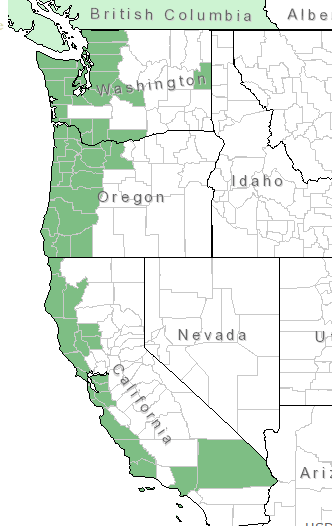
Distribution of Coast Black Gooseberry from USDA Plants Database
Distribution: Coast Black Gooseberry is found from southern British Columbia to the south-central California coast; mostly on the west side of the Cascades in Oregon and Washington.
Growth: It grows 4-9 feet (1.5-3m) tall.
Habitat: It can be found in open woods, prairies and moist hillsides. Wetland designation: FAC*, Facultative, it is equally likely to occur in wetlands or non-wetlands.
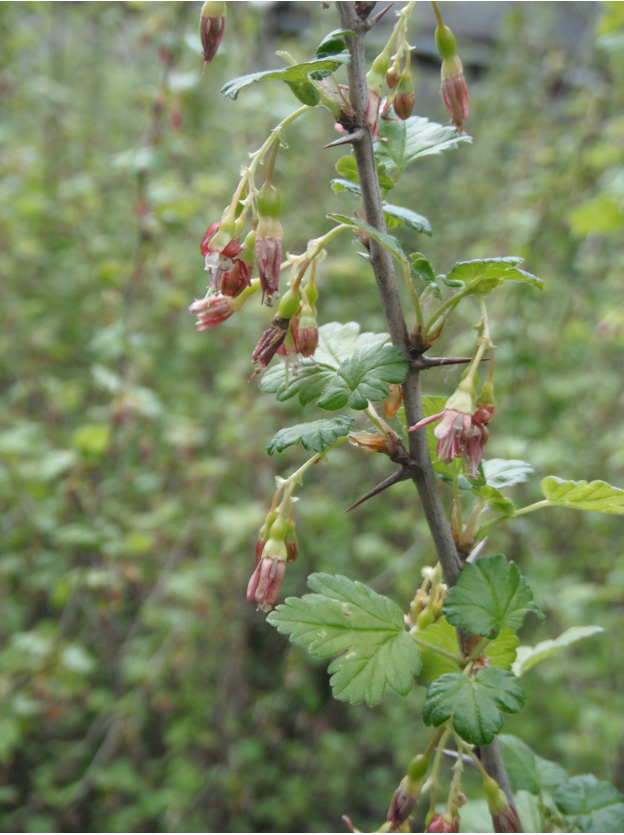 Diagnostic Characters: Coast Black Gooseberry stems grow erect, tending to arch, or they spread with 1-3 stout, chestnut-colored spines at the nodes with occasionally bristles on the internodes (more frequent on young twigs). Bark is gray to somewhat brownish. Leaves are usually 3-lobed, the lower lobes unequally divided again. The leaf petioles are often longer than the leaf blades. Flowers are borne in fuchsia-like, drooping clusters of 2-3. The 5-lobed calyx is usually red or red-green; 5 petals are white to red; 5 stamens and 2 styles extend past calyx lobes. Purplish-black berries are round and smooth.
Diagnostic Characters: Coast Black Gooseberry stems grow erect, tending to arch, or they spread with 1-3 stout, chestnut-colored spines at the nodes with occasionally bristles on the internodes (more frequent on young twigs). Bark is gray to somewhat brownish. Leaves are usually 3-lobed, the lower lobes unequally divided again. The leaf petioles are often longer than the leaf blades. Flowers are borne in fuchsia-like, drooping clusters of 2-3. The 5-lobed calyx is usually red or red-green; 5 petals are white to red; 5 stamens and 2 styles extend past calyx lobes. Purplish-black berries are round and smooth.
In the Landscape: Coast Black Gooseberry is a little too wild and wicked for a formal garden, but can find a place in a wild garden away from paths where an unsuspecting ambler could be poked by its nasty spines. Flowers are small but a colorful red and white.
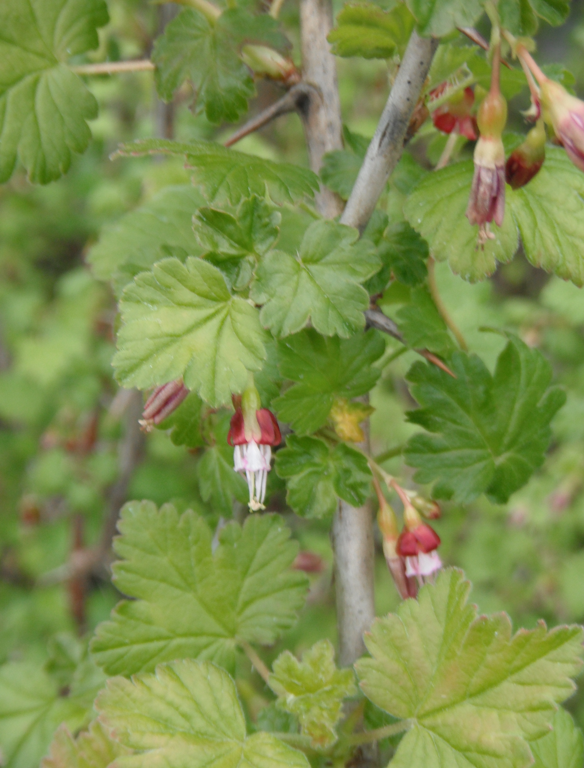 Phenology: Bloom time: April-May; Fruit ripens: July-August.
Phenology: Bloom time: April-May; Fruit ripens: July-August.
Propagation: It is easily grown from seed sown outside or in a cold frame in fall. Stored seed may be stratified at 35º F (2º C) for 120 days. Hardwood cuttings taken in fall or semi-hardwood, earlier in summer, are also possible.
Use by People: Natives variously ate the berries fresh, dried them for storage or baked them into cakes. Unripe berries were sometimes eaten fresh, dried or made into a sauce. The inner bark was chewed and swallowed to treat a sore throat and cold. The bark or roots were boiled and used as an eyewash, or for sore throats. The Nisqually used the spines for tattooing using charcoal for coloring. Some consider this to be one of the finest of the wild North American gooseberries. It is sweet and juicy, though a bit on the acid side, with a “very acceptable flavor.”
Use by Wildlife: The flowers attract hummingbirds. The berries attract many birds including grosbeaks.
Links:
Consortium of Pacific Northwest Herbaria
WTU Herbarium Image Collection, Plants of Washington, Burke Museum
E-Flora BC, Electronic Atlas of the Flora of British Columbia
Jepson Eflora, University of California
Ladybird Johnson Wildflower Center
Native American Ethnobotany, University of Michigan, Dearborn

